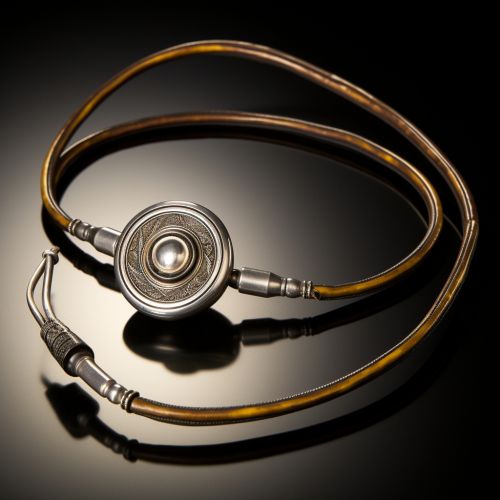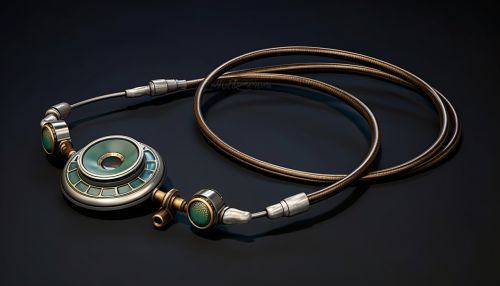Stethoscope
Introduction
The Stethoscope is a medical instrument used for auscultation, or listening to the internal sounds of a human or animal body. It typically has a small disc-shaped resonator that is placed against the chest, and two tubes connected to earpieces. The stethoscope was invented in France in 1816 by René Laennec and has become one of the most universally recognized symbols of healthcare professionals.
History
The stethoscope was invented by René Laennec at the Necker-Enfants Malades Hospital in Paris in 1816. Laennec invented the stethoscope because he was uncomfortable placing his ear directly onto a woman's chest to listen to her heart. His initial version of the stethoscope was a simple wooden tube, similar to the common ear trumpet, a historical form of hearing aid. It was monaural and was made of cedar.


Design and Function
The stethoscope is an acoustic medical device for auscultation, or listening to the internal sounds of an animal or human body. It often has a small disc-shaped resonator that is placed against the skin, and one or two tubes connected to two earpieces. A stethoscope can be used to listen to the heart, lungs, and intestines.
Types of Stethoscopes
There are several types of stethoscopes used in the field of medicine. The most common type is the acoustic stethoscope, which operates on the transmission of sound from the chest piece, via air-filled hollow tubes, to the listener's ears. Another type, the electronic stethoscope, amplifies body sounds electronically by converting acoustic sound waves to electrical signals which can then be amplified for optimal listening. Other types include the fetal stethoscope or fetoscope, Doppler stethoscope, and the 3D-printed stethoscope.
Acoustic Stethoscope
The acoustic stethoscope operates on the transmission of sound from the chest piece, via air-filled hollow tubes, to the listener's ears. The chest piece usually consists of two sides that can be placed against the patient for sensing sound. The flat surface is the diaphragm, and the smaller, concave surface is the bell. By using the bell, low-frequency sounds can be heard more clearly, while the diaphragm allows high-frequency sounds to be heard.
Electronic Stethoscope
The electronic stethoscope, also known as a digital stethoscope, amplifies body sounds electronically by converting acoustic sound waves to electrical signals which can then be amplified for optimal listening. Unlike acoustic stethoscopes, which are all based on the same physics, transducers in electronic stethoscopes vary widely. The simplest and least effective method of sound detection is achieved by placing a microphone in the chest piece.
Fetal Stethoscope
A fetal stethoscope or fetoscope is a stethoscope designed to listen to the heartbeat of a fetus during pregnancy. It is a long, horn-shaped tube that allows the healthcare provider to listen to the heart sounds of the fetus without the use of electronic equipment. The fetoscope is placed on the abdomen of the pregnant woman and the healthcare provider listens to the other end.
Doppler Stethoscope
The Doppler stethoscope is a recent development, and is superior in certain situations such as for use in noisy environments. Doppler stethoscopes are used to measure the velocity of blood flow. The Doppler stethoscope is used primarily by cardiologists and other medical professionals who require a more sophisticated instrument.
3D-Printed Stethoscope
The 3D-printed stethoscope is an open-source medical device meant for auscultation and manufactured via 3D printing. The 3D-printed stethoscope was developed by Dr. Tarek Loubani and a team of medical and technology specialists as part of the Glia project. The stethoscope can be printed for less than $3 in materials and, after validation, was found to perform as well or better than the market-leading model on the market.
